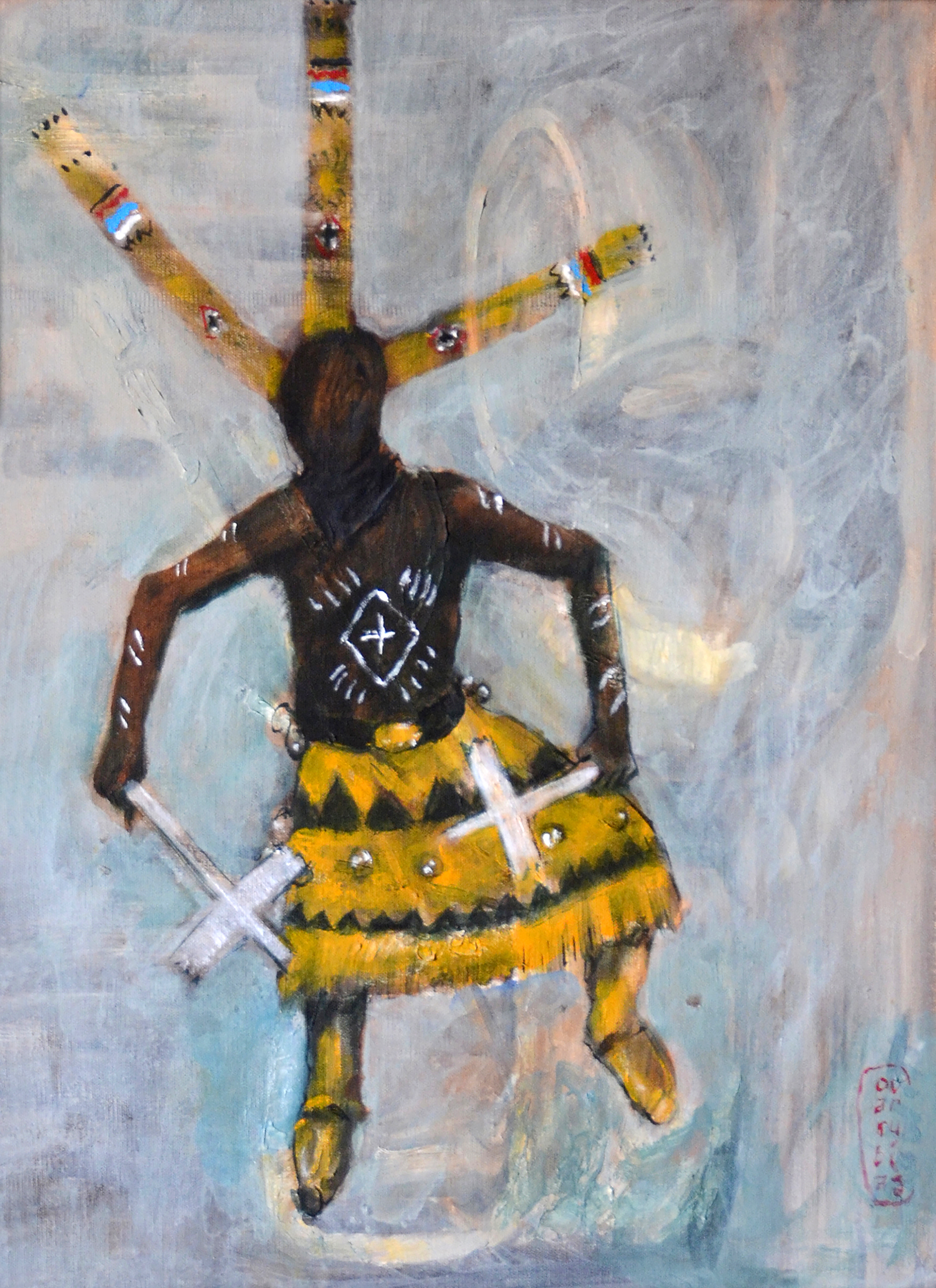
Apache at the Pueblo, 2015; 20" x 16"

Apache Crown Dancer, 2011; 22" x 16"

Apache Ga'an Dancer, 2011; 48.5" x 49.75"
There are five dancers in the Apache Ga’an, or Crown, dance ceremonies. Four of the dancers are mountain spirits or spiritual ancestors that represent the cardinal directions, as well as lightning, clouds, rain, and snow. They each bring one of these natural blessings to the people (Inde”). The four dancers paint their bodies black and white and adorn themselves with lightning designs and animal motifs. The fifth dancer represents First Man (I’toi) honoring the ancestors and the original innocence of mankind. He is painted gray and plays the part of an unpredictable clown who is a messenger between the Apache and the Spirit People.
Traditionally, the dance would last four days as a healing ceremony to evoke blessings and ward off evil for the community. The sacred belief is that the Creator sends the Ga'an to guide the people, teaching them the path to a harmonious life with each other and the land. Often, tribal makers and artists carve Kachinas of the Ga’an from cottonwood or saguaro. Personal experiences with the traditions, photographs, or sculptures by other artists inspire Jim's paintings of ceremonial characters.

Bear Clan Fetish Effigy, 2005; 36" x 48"

Butterfly Dance, 2012; 60" x 48"

Chanupa (Sacred Pipe), 2014; 37.5" x 29"

Cherokee Love Song, 2005; 48" x 36"

Cheyenne, 1989; 50" x 70"

Cinco de Mayo, 2003; 36" x 48"
In 1862, the French Foreign Legion arrived at the city walls of Puebla, Mexico. They were to siege the town. Benito Juarez, President-elect of Mexico, a full-blooded Zapotec Indian, sent young general Zaragoza, a 28-year-old graduate of the prestigious Chapultepec Military Academy, the West Point of Mexico and a Cavalry Brigade to check the French. They were joined by townsfolk militia and natives from the area (Opata and Otomi). They charged out of Puebla the morning of May 5 and began a hand to hand battle with the surprised French who had just arrived the day before and were still setting up their siege cannons. The vicious fighting raged for 4 hours, and then the French bid a hasty adieu to Zaragosa led troops and the hornet’s nest they marched into. Two of Zaragosa's lieutenants would later be Presidents of Mexico.

Crow Mother Kachina, 2001; 40" x 30"

Deer Dancer, 2004; 38" x 46"

Geronimo Planning the Raid, 2014; 20" x 24"

Geronimo, 1997; 36" x 48"

Hastin Acanti Badanie, 2012; 20" x 16"

Hopi Dancers, 2013; 35.5" x 24"

Hopi Girl, 2014; 48" x 36"

Magical Warrior, 2000; 48" x 36"

Mandan, 2011; 24" x 18"

Mexica, 2012; 12" x 9"

Mohave Girl, 1998; 71" x 51"

Nambe, 1998; 60" x 48"

Shaman, 2011; 48" x 48"

Sky People, 1998; 48" x 62"

The Race, 2011; 18" x 24"

Vision Quest, 1998; 55.25" x 70.75"
In some Native American cultures, young males entering adulthood undertake a vision quest as a rite of passage. This type of rite usually consists of a series of ceremonies, fasting, and spending time alone in nature or at a sacred site. The young person would pray to the spirits for a vision to help them find their purpose or role in the world and their community. Usually interpreted by an elder, the vision would lead them into adulthood and guide their future experiences.
Running you pray
Fasting you pray
Dreaming you pray
Sweatlodge you pray
On the mountain you're alone
You see your family
Those who have passed
Pangs of guilt and regret grip the pit of your stomach
You suffer from hunger, thirst, fear and doubt
You are lost, blind and exhausted
You see a light, it washes over you
Your spirit is free and lite
The Good Red Road is before you
You are Oyate Lute!
People of the Chanupah!
You walk on the Good Red Road!
Ho-kah-hey!

Wapiti, 1995; 34" x 34"

Wild Horses, 2010; 36" x 40"

Zanjero, 2008; 24" x 36"



























